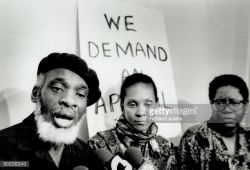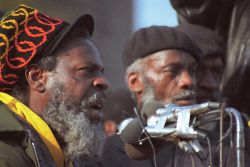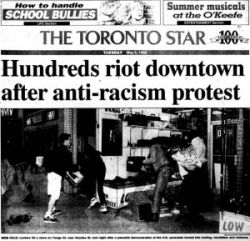Toronto Media Co-op
Local Independent News
Toronto’s 1992 Yonge Street Uprising: Afrikan Resistance to State/Police Violence
By Ajamu Nangwaya
"By what standard of morality can the violence used by a slave to break his chains be considered the same as the violence of a slave master?"
- Dr. Walter Rodney
The May 4, 1992 Yonge Street Uprising was a pivotal moment in the resistance history of Afrikan people in the city of Toronto. This rebellion is the first and only one led by Afrikans against racial and class oppression in this metropolitan area. It forced the Ontario New Democratic Party (ONDP) government of the day to enact a slew of anti-racist and equity public policy initiatives.
The Yonge Street Uprising shared the same proximate triggering event as that which tend to inspire rebellions among Afrikans in the United States. An act of police violence was the immediate cause that led to this uprising in Toronto and the same factor is at work in the urban insurrections that have broken out in America since the 1960s to today.
The cops are the front-line personnel of the occupation army-like presence that is the police department in Afrikan working-class or racialized communities across Canada and the United States. The writer James Baldwin accurately captures the operational dynamic that makes incidents of police violence the tripwire for urban rebellion in an article in Esquire in 1960:
“…the only way to police a ghetto is to be oppressive. None of commissioner Kennedy's policemen, even with the best will in the world, have any way of understanding the lives led by the people they swagger about in two's and three's controlling. Their very presence is an insult, and it would be, even if they spent their entire day feeding gumdrops to children. They represent the force of the white world, and that world's real intentions are, simply, for that world's criminal profit and ease, to keep the black man (and woman) corralled up here, in… [their] place. The badge, the gun in the holster, and the swinging club make vivid what will happen should… [their] rebellion become overt.”
In Toronto of the late 1980s and early 1990s there were a number of cases of police killing and wounding of Afrikans and it created a powder keg-like situation in many neighbourhoods against the appearance of an open season on this racialized group. The Yonge Street Uprising erupted over Toronto cop Robert Rice killing of the 22-year-old Afrikan youth Raymond Lawrence in a west end neighbourhood.
A demonstration was called by the Black Action Defense Committee, the leading activist police accountability group in Toronto at the time, to demonstrate against this latest case of police violence. It attracted over one thousand participants. This protest action was also expressing solidarity with the Los Angeles (Rodney King) Rebellion that emerged from the acquittal of the cops for their brutal attack on Afrikan American civilian Rodney King.
Many Afrikans in Toronto and across Canada had been watching the unfolding of the uprising in Los Angeles and shared the pain of the Afrikan American community from the blatant injustice of the jury’s decision. The rage and solidarity of the Afrikans in Toronto for the insurrection in Los Angeles came from their lived experiences of undue police surveillance, beatings and the use of deadly force.
The Yonge Street Uprising was an unexpected act of resistance to the municipal political authority and the police top brass. They had rubbished the idea that Afrikans in Toronto would engage in a rebellion like their fictive kin in Los Angeles. This youth led insurrection totally surprised the political, economic and cultural elites because of their tendency to imbibe on the notion of Canadian exceptionalism when it comes to white supremacy, class oppression and policing.
It was reported in the July 29, 1992 edition of The Windsor Star that seventy-five people were charged with criminal offences, about $250,000 property damage was done to 105 businesses and over $112,000 worth of unrecovered stolen goods were some of the outcomes of the Young Street Uprising.
The rebellion alarmed Premier Bob Rae to such an extent that he commissioned the former United Nations ambassador and leader of the ONDP Stephen Lewis to look into the root causes of this social unrest. Lewis carried out a broad consultation with racialized communities, especially the Afrikan community in Ontario, and issued the report within thirty days of being tasked with this responsibility.
Lewis quite rightly located the roots of the rebellion in social factors and the oppressive condition of Afrikan life in Ontario:
“First, what we are dealing with, at root, and fundamentally, is anti-Black racism. While it is obviously true that every visible minority community experiences the indignities and wounds of systemic discrimination throughout Southern Ontario, it is the Black community which is the focus. It is Blacks who are being shot, it is Black youth that is unemployed in excessive numbers, it is Black students who are being inappropriately streamed in schools, it is Black kids who are disproportionately dropping-out, it is housing communities with large concentrations of Black residents where the sense of vulnerability and disadvantage is most acute, it is Black employees, professional and non-professional, on whom the doors of upward equity slam shut. Just as the soothing balm of ‘multiculturalism’ cannot mask racism, so racism cannot mask its primary target.”
The centring of the uprising’s origin in social and economic factors strongly contradicted the claims of media pundits, reporters, Mayor June Rowlands, the police chief William McCormack, Toronto Police Services Board chair Susan Eng, Ontario Premier Bob Rae and a range of society’s notables. They saw the Yonge Street Uprising as an exercise in hooliganism, criminality and/or opportunism by wayward elements in Toronto.
Prime Minister Brian Mulroney gave the nod to social factors as possible reasons behind the rebellion. However, he was adamant that racism was not a cause, “I think Canadians ought to refrain from the suggestion that all of a sudden Canada's engulfed with very, very grave and overriding problems of racism” as reported in the May 6, 1992 edition of the Montreal Gazette.
However, the Rae-led ONDP government immediately initiated a series of reformist anti-racism and equity social policies and programmes to respond to the underlying grievances of the Young Street Uprising. Since the 1991 creation of the Ontario Anti-Racism Secretariat, which replaced the feeble Race Relations Directorate and head by a top ranking bureaucrat, anti-racism advocates among the petty bourgeoisie had been pleading with the government to demonstrate a greater commitment to anti-racism.
The Yonge Street Uprising was akin to a gift from the gods to the Secretariat because in the aftermath of this social unrest, its mandate and activities rapidly expanded. According to Stefano Harney, former Manager of Community Education and Economic Resources with the Secretariat in an article in the journal Race & Class, “By the end of 1992, the Secretariat had over fifty staff and its senior officials were present on all important cabinet committees and interministerial committees. An anti-racism policy was in the works for the government…. The Secretariat was at the heights of its power.”
It took an assertive and demonstrative initiative from below and not the polite lobbying through official channels by the petty bourgeois race relations champions to force the hand of the state. In addition to the strengthening of that anti-racism body within the state a number of measures were taken to stave off the possibility of a long hot summer of social unrest.
The ONDP government pumped a $1 million dollars into the Jobs Ontario Youth employment placement programme directed at Afrikan youth and their socially marginalized counterparts. The Fresh Arts Progam received funding from this jobs programme and it nurtured working-class cultural workers or artistes such Jully Black, Baby Blue Sound Crew, Kardinal Offishall, Saukrates and Lil’ X. Trey Anthony and d'bi.young.anitafrika were also spawned by this programme.
The government also provided millions of dollars in funding in modest grants to community development initiatives aimed at fighting white supremacy. A credit union project in the Afrikan community received funding to address its financial services and community economic needs.
The prison industrial complex and its swallowing of large number of Afrikan Canadians into its bowel has been a longstanding issue in the community. In October 1992, the state created the Commission on Systemic Racism in Ontario the Criminal Justice System and gave it the mandate to “report and make recommendations on systemic racism and the criminal justice system.” The Commission’s co-chair was Margaret Gittens, an Afrikan woman, with a track record of principled anti-racism advocacy.
White supremacist employment barriers in the workplaces in Ontario are a major problem for Afrikans, other racialized peoples and Indigenous peoples. The rebellion pushed the government into creating the Employment Equity Act in 1993, and it had the strongest accountability measure in Canada in terms of the level of fine for an infraction of the legislation. The law covered four protected groups: racialized people, Indigenous peoples, women and people with disabilities. However, the animus toward the law was largely based on racist sentiments. This piece of legislation was immediately rescinded in 1995 by the incoming right-wing Progressive Conservative-led regime of Mike Harris.
The ONDP government initiated anti-racism and equity policies in the school system across Ontario in order to respond to systemic racism in that institution.
People tend to be tolerant of the structural violence of poverty, homelessness and inadequate housing, lack of access to healthcare, limited access to education, unsafe workplace, the pollution of land, air and water, and unemployment and underemployment that can contribute to the premature death or a compromised quality of life for oppressed. When people are not able to meet their basic needs in a world with the available resources, they are experiencing structural violence.
However, when the oppressed take matters into their own hands and bring the physical fight to the oppressor, they are usually vilified and further criminalized for using violence. The Yonge Street Uprising has made it clear that the oppressed might have to resort to violence in order to occupy the stage of history as the principal actors in the drama of emancipation. The abolitionist, writer and statesman Frederick Douglass asserts that resistance to oppression is a basic condition of life:
“Power concedes nothing without a demand. It never did and it never will. Find out just what any people will quietly submit to and you have found out the exact measure of injustice and wrong which will be imposed upon them, and these will continue till they are resisted with either words or blows, or with both. The limits of tyrants are prescribed by the endurance of those whom they oppress.”
Ajamu Nangwaya, Ph.D., is an educator, organizer and writer. He is an organizer with the Network for the Elimination of Police Violence.
About the poster
The site for the Toronto local of The Media Co-op has been archived and will no longer be updated. Please visit the main Media Co-op website to learn more about the organization.


